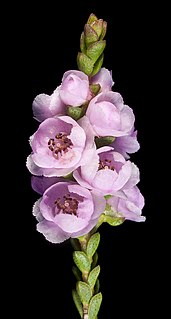
Thryptomene is a genus of flowering plants in the family Myrtaceae and is endemic to Australia. Plants in the genus Thryptomene are shrubs with small leaves arranged in opposite pairs and white or pink flowers. About forty-seven species of Thryptomene, occurring in all Australian states and the Northern Territory, have been formally described.

Acacia pyrifolia, commonly known as ranji bush is a shrub that is endemic to the north of Western Australia.

Thryptomene baeckeacea is a shrub species in the family Myrtaceae. It grows to between 0.2 and 1.2 metres high and produces white, pink or purple flowers between May and October in the species' native range. The species is endemic to Western Australia.

Thryptomene hyporhytis is a shrub species in the family Myrtaceae. It grows to between 0.2 and 0.7 metres high and produces white or pink flowers between June and October in the species' native range. The species is endemic to Western Australia.
Thryptomene biseriata is a species of flowering plant in the family Myrtaceae and is endemic to arid areas of southern central Australia. It is an erect, multi-stemmed shrub with more or less round to club-shaped leaves and pink flowers with five petals and five stamens.
Thryptomene caduca is a species of flowering plant in the family Myrtaceae and is endemic to a small area in the north-west of Western Australia. It is a spreading shrub with crowded egg-shaped leaves with the narrower end towards the base, and pink flowers with five petals and seven to nine stamens.
Thryptomene cuspidata is a shrub species in the family Myrtaceae that is endemic to Western Australia.
Thryptomene decussata is a species of flowering plant in the family Myrtaceae and is endemic to Western Australia. It is an erect shrub with upward pointing, egg-shaped leaves, and white or pink flowers with five petals and twenty to thirty stamens in two whorls.

Thryptomene denticulata is a shrub species in the family Myrtaceae that is endemic to Western Australia.
Thryptomene dampieri is a species of flowering plant in the family Myrtaceae and is endemic to the north-west of Western Australia. It is a low, spreading shrub with prostrate stems, broadly egg-shaped leaves with the narrower end towards the base, and pinkish flowers with five petals and ten stamens.
Thryptomene eremaea is a shrub species in the family Myrtaceae that is endemic to Western Australia.
Thryptomene johnsonii is a shrub species in the family Myrtaceae that is endemic to Western Australia.
Thryptomene kochii is a shrub species in the family Myrtaceae that is endemic to Western Australia.
Thryptomene naviculata is a shrub species in the family Myrtaceae that is endemic to Western Australia.
Thryptomene nealensis is a shrub species in the family Myrtaceae that is endemic to Western Australia.

Thryptomene racemulosa is a shrub species in the family Myrtaceae that is endemic to Western Australia.

Thryptomene stenophylla is a shrub species in the family Myrtaceae that is endemic to Western Australia.
Thryptomene striata is a shrub species in the family Myrtaceae that is endemic to Western Australia.
Thryptomene urceolaris is a shrub species in the family Myrtaceae that is endemic to Western Australia.
Thryptomene wittweri is a shrub species in the family Myrtaceae that is endemic to Western Australia.






